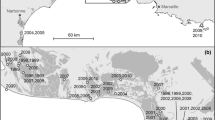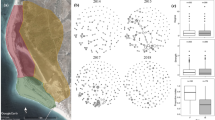Abstract
Understanding the evolution of gregarious breeding in birds necessitates assessing how fitness components vary in relation to conspecific density. So far, the ultimate causes of breeding density remain contentious, owing to the logistic challenges in both obtaining and interpreting long-term effects of density on fledgling survival, recruitment rates or natal dispersal in wild populations. Here, we used observational data from a 13-year study on the reproduction of a facultatively gregarious bird, the Spotless Starling, Sturnus unicolor, to investigate the consequences of breeding density for fitness and offspring natal dispersal. We compared breeding performance, recruitment success and dispersal distances of offspring arising from nest-boxes placed in either a high (HD) or a low density (LD). We found that although neither clutch size nor fledgling survival varied in relation to density, HD nests produced significantly fewer recruits. Moreover, recruits from HD nests settled closer to their natal territories than those from LD nests. These findings suggest that the proximity to neighbours incurs delayed fitness costs in the Spotless Starling. Furthermore, the negative density-dependent dispersal may result from the increased mortality of individuals in worse condition and with lower ability to compete for breeding vacancies in the vicinity of their natal territories. With this study, we provide long-term observational results that may be a basis for further experiments intended to unravel proximate mechanisms underpinning density-dependent patterns in wild breeding colonies.
Zusammenfassung
Langfristige Fitnesskonsequenzen der Brutdichte bei Starenkolonien: ein Beobachtungsansatz
Um die Evolution des gemeinschaftlichen Brütens bei Vögeln zu verstehen, ist es erforderlich, die wesentlichen Fitnesskomponenten festzustellen, die in Bezug auf die Siedlungsdichte variieren. Bis zum jetzigen Zeitpunkt bleiben die letztendlichen Ursachen für die Brutdichten umstritten. Ursache dafür sind die logistischen Herausforderungen bei der Feststellung und Interpretation langfristiger Auswirkungen der Brutdichte in Wildpopulationen auf die Überlebenswahrscheinlichkeit der flüggen Jungvögel, Rekrutierungsrate oder Abwanderung der Jungvögel. In dieser Studie nutzten wir die Beobachtungsdaten einer 13-jährigen Studie über die Reproduktion einer fakultativ in Kolonien brütenden Vogelart, dem Einfarbstar, Sturnus unicolor, um die Konsequenzen der Brutdichte auf die Fitness und Abwanderung der Nachkommen zu untersuchen. Wir verglichen die Brutleistung, den Rekrutierungserfolg und die Abwanderungsdistanzen der Nachkommen, die aus Nestboxen stammen, welche entweder in einer hohen (HD; engl. high density) oder niedrigen (LD; engl. low density) Dichte angebracht worden sind. Wir fanden heraus, dass HD-Nester weniger Rekruten (Erstbrüter) hervorbrachten, obwohl sich weder die Gelegegröße noch die Überlebenswahrscheinlichkeit der flüggen Jungvögel in Bezug auf die Brutdichte unterschieden. Weiterhin siedelten sich Rekruten von HD-Nestern näher am eigenen Schlupfort an als Rekruten von LD-Nestern. Diese Funde lassen vermuten, dass die Nähe zu den Artgenossen zu verspätete Fitnesskosten beim Einfarbstar führt. Weitere Gründe für die geringe Abwanderung bei einer höheren Siedlungsdichte (engl. negative density-dependent dispersal) könnten eine erhöhte Sterblichkeit bei Individuen mit schlechterer Kondition und eine niedrigere Konkurrenzfähigkeit bezüglich freier Brutmöglichkeiten in Schlupfortnähe sein. Mit dieser Studie können wir Ergebnisse aus langfristigen Beobachtungen zur Verfügung stellen, welche als Grundlage für künftige Experimente dienen können. Diese sollten zum Ziel haben, unmittelbare Mechanismen zu untersuchen, die den dichteabhängigen Mustern in Brutkolonien freilebender Vogelarten zugrunde liegen.



Similar content being viewed by others
References
Angulo E, Luque GM, Gregory SD, Wenzel JW, Bessa-Gomes C, Berec L, Courchamp F (2018) Allee effects in social species. J Anim Ecol 87:47–58
Bates D, Maechler M, Bolker B, Walker S (2015) Fitting linear mixed-effects models. Using lme4. J Stat Softw 67:1–48
Bentz AB, Navara KJ, Siefferman L (2013) Phenotypic plasticity in response to breeding density in tree swallows: an adaptive maternal effect? Horm Behav 64:729–736
Both C (1998) Experimental evidence for density dependence of reproduction in great tits. J Anim Ecol 67:667–674
Brown CR, Brown MB (1986) Ectoparasitism as a cost of coloniality in cliff swallows (Hirundo pyrrhonota). Ecology 67:1206–1218
Brown CR, Brown MB (2001) Avian coloniality. In current ornithology. Springer, Boston
Cramp S, Perrins CM (1994) Handbook of the birds of Europe, the Middle East and North Africa, vol VIII. Oxford University Press, Oxford
Danchin E, Wagner RH (1997) The evolution of coloniality: the emergence of new perspectives. Tree 12:342–347
Danchin E, Boulinier T, Massot M (1998) Conspecific reproductive success and breeding habitat selection: implications for the study of coloniality. Ecology 79:2415–2428
Evans JC, Votier SC, Dall SR (2016) Information use in colonial living. Biol Rev 91:658–672
Fernandez C, Azkona P, Donázar JA (1998) Density-dependent effects on productivity in the griffon vulture Gyps fulvus: the role of interference and habitat heterogeneity. Ibis 140:64–69
Ferrer M, Donazar JA (1996) Density-dependent fecundity by habitat heterogeneity in an increasing population of Spanish imperial eagles. Ecology 77:69–74
Forero MG, Donázar JA, Hiraldo F (2002) Causes and fitness consequences of natal dispersal in a population of black kites. Ecology 83:858–872
Green DJ, Cockburn A (2001) Post-fledging care, philopatry and recruitment in brown thornbills. J Anim Ecol 70:505–514
Greenwood PJ (1980) Mating systems, philopatry and dispersal in birds and mammals. Anim Behav 28:1140–1162
Griffiths R, Double MC, Orr K, Dawson RJ (1998) A DNA test to sex most birds. Mol Ecol 7:1071–1075
Hötker H (2000) Intraspecific variation in size and density of Avocet colonies: effects of nest-distances on hatching and breeding success. J Avian Biol 31:387–398
Jungwirth A, Josi D, Walker J, Taborsky M (2015) Benefits of coloniality: communal defence saves anti-predator effort in cooperative breeders. Funct Ecol 29:1218–1224
Kim SY, Torres R, Drummond H (2009) Simultaneous positive and negative density-dependent dispersal in a colonial bird species. Ecology 90:230–239
Lack D (1954) The natural regulation of animal numbers. Oxford University Press, New York
Lambin X, Aars J, Piertney SB (2001) Kin and local competition and dispersal: a review of the empirical evidence. Oxford University Press, Oxford (In Dispersal)
López-Rull I, Celis P, Salaberria C, Puerta M, Gil D (2011) Post-fledging recruitment in relation to nestling plasma testosterone and immunocompetence in the Spotless Starling. Funct Ecol 25:500–508
Martín CA, Alonso JC, Alonso JA, Palacín C, Magaña M, Martín B (2008) Natal dispersal in great bustards: the effect of sex, local population size and spatial isolation. J Anim Ecol 77:326–334
Matthysen E (2005) Density-dependent dispersal in birds and mammals. Ecography 28:403–416
Negro JJ, Hiraldo F, Donázar JA (1997) Causes of natal dispersal in the lesser kestrel: inbreeding avoidance or resource competition? J Anim Ecol 66:640–648
Nevoux M, Gimenez O, Arlt D, Nicoll M, Jones C, Norris K (2011) Population regulation of territorial species: both site dependence and interference mechanisms matter. Proc R Soc Lond B 278:2173–2181
Nicolaus M, Tinbergen JM, Ubels R, Both C, Dingemanse NJ (2016) Density fluctuations represent a key process maintaining personality variation in a wild passerine bird. Ecol Lett 19:478–486
Parejo D, White J, Clobert J, Dreiss A, Danchin E (2007) Blue tits use fledgling quantity and quality as public information in breeding site choice. Ecology 88:2373–2382
Parejo D, Pérez-Contreras T, Navarro C, Soler JJ, Avilés JM (2008) Spotless Starlings rely on public information while visiting conspecific nests: an experiment. Anim Behav 75:483–488
Picman J, Pribil S, Isabelle A, Powell A (2002) Antipredation value of colonial nesting in yellow headed blackbirds. Auk 119:461–472
Pilz KM, Smith HG (2004) Egg yolk androgen levels increase with breeding density in the European Starling, Sturnus vulgaris. Funct Ecol 18:58–66
Poethke HJ, Hovestadt T (2002) Evolution of density and patch size dependent dispersal rates. Proc R Soc Lond B 269:637–645
Polo V, López-Rull I, Gil D, Veiga JP (2010) Experimental addition of green plants to the nest increases testosterone levels in female Spotless Starlings. Ethology 116:129–137
Polo V, Rubalcaba JG, Veiga JP (2015) Green plants in nests reduce offspring recruitment rates in the Spotless Starling. Behav Ecol 26:1131–1137
R Core Team (2017) R: A language and environment for statistical computing. R Foundation for Statistical Computing, Vienna
Rodrigues AM, Johnstone RA (2014) Evolution of positive and negative density-dependent dispersal. Proc R Soc Lond B 281:20141226
Rubalcaba JG, Fuentes D, Veiga JP, Polo V (2017) Nest decoration as social signals by males and females: greenery and feathers in starling colonies. Behav Ecol 28:1369–1375
Serrano D, Oro D, Ursua E, Tella JL (2005) Colony size selection determines adult survival and dispersal preferences: allee effects in a colonial bird. Am Nat 166:E22–E31
Serrano-Davies E, Barrientos R, Sanz JJ (2017) The role of nest-box density and placement on occupation rates and breeding performance: a case study with Eurasian blue tits. Ornis Fennica 94:21–32
Stephens PA, Sutherland WJ, Freckleton RP (1999). What is the Allee effect? Oikos 87:185–190
Sutherland WJ (1996) From individual behaviour to population ecology. Oxford University Press, Oxford
Veiga JP, Polo V (2008) Fitness consequences of increased testosterone levels in female Spotless Starlings. Am Nat 172:42–53
Veiga JP, Moreno J, Cordero PJ, Mínguez E (2001) Territory size and polygyny in the Spotless Starling: resource-holding potential or social inertia? Can J Zool 79:1951–1956
Veiga JP, Polo V, Viñuela J (2006) Nest green plants as a male status signal and coutship display in the Spotless Starling. Ethology 112:196–204
Veiga JP, Polo V, Arenas M, Sánchez S (2012) Intruders in nests of the Spotless Starling: prospecting for public information or for immediate nesting resources? Ethology 118:917–924
Wagner RH (1993) The pursuit of extra-pair copulations by female birds: a new hypothesis of colony formation. J Theor Biol 163:333–346
Acknowledgements
Financial support was provided by the Spanish Ministry of Economy and Competitiveness (project number CGL2014-59670-P). D.F was supported by PhD grant by the Spanish Government. The authors particularly thank Kala Thaker for kindly revising the writing style, and two reviewers for their suggestions to improve an earlier version of the manuscript.
Author information
Authors and Affiliations
Corresponding author
Additional information
Communicated by C. Barbraud.
Publisher's Note
Springer Nature remains neutral with regard to jurisdictional claims in published maps and institutional affiliations.
Electronic supplementary material
Below is the link to the electronic supplementary material.
Rights and permissions
About this article
Cite this article
Fuentes, D., Rubalcaba, J.G., Veiga, J.P. et al. Long-term fitness consequences of breeding density in starling colonies: an observational approach. J Ornithol 160, 1035–1042 (2019). https://doi.org/10.1007/s10336-019-01674-7
Received:
Revised:
Accepted:
Published:
Issue Date:
DOI: https://doi.org/10.1007/s10336-019-01674-7




